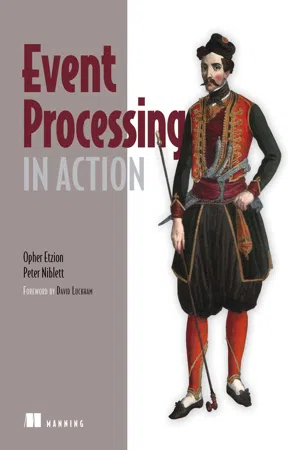
- 384 pages
- English
- ePUB (mobile friendly)
- Available on iOS & Android
Event Processing in Action
About this book
Unlike traditional information systems which work by issuing requests and waiting for responses, event-driven systems are designed to process events as they occur, allowing the system to observe, react dynamically, and issue personalized data depending on the recipient and situation. Event Processing in Action introduces the major concepts of event-driven architectures and shows how to use, design, and build event processing systems and applications. Written for working software architects and developers, the book looks at practical examples and provides an in-depth explanation of their architecture and implementation. Since patterns connect the events that occur in any system, the book also presents common event-driven patterns and explains how to detect and implement them. Throughout the book, readers follow a comprehensive use case that incorporates all event processing programming styles in practice today. Purchase of the print book comes with an offer of a free PDF, ePub, and Kindle eBook from Manning. Also available is all code from the book.
Frequently asked questions
- Essential is ideal for learners and professionals who enjoy exploring a wide range of subjects. Access the Essential Library with 800,000+ trusted titles and best-sellers across business, personal growth, and the humanities. Includes unlimited reading time and Standard Read Aloud voice.
- Complete: Perfect for advanced learners and researchers needing full, unrestricted access. Unlock 1.4M+ books across hundreds of subjects, including academic and specialized titles. The Complete Plan also includes advanced features like Premium Read Aloud and Research Assistant.
Please note we cannot support devices running on iOS 13 and Android 7 or earlier. Learn more about using the app.
Information
Part 1. The basics
Chapter 1. Entering the world of event processing
I am more and more convinced that our happiness or unhappiness depends far more on the way we meet the events of life, than on the nature of those events themselves.Wilhelm von Humboldt
- An explanation of what we mean by events, using examples from daily life
- Examples of computerized event processing in use, and the reasons for its use
- An introduction to the main concepts of event processing
- The idea of a dedicated event processing platform and its business value
- The relationship of event processing to other computing concepts
- An introduction to the Fast Flower Delivery application that accompanies us throughout this book
- A description of the Event Processing in Action website, http://www.ep-ts.com/EventProcessingInAction
1.1. Event-driven behavior and event-driven computing
1.1.1. What we mean by events
Event
1.1.2. Event-driven behavior in daily life
Table of contents
- Copyright
- Brief Table of Contents
- Table of Contents
- Foreword
- Preface
- Acknowledgments
- About the Cover Illustration
- Part 1. The basics
- Chapter 1. Entering the world of event processing
- Chapter 2. Principles of event processing
- Part 2. The building blocks
- Chapter 3. Defining the events
- Chapter 4. Producing the events
- Chapter 5. Consuming the events
- Chapter 6. The event processing network
- Chapter 7. Putting events in context
- Chapter 8. Filtering and transformation
- Chapter 9. Detecting event patterns
- Part 3. Pragmatics
- Chapter 10. Engineering and implementation considerations
- Chapter 11. Today’s event processing challenges
- Chapter 12. Emerging directions of event processing
- Appendix A. Definitions
- Appendix B. The Fast Flower Delivery application
- Index
- List of Figures
- List of Tables
- List of Listings